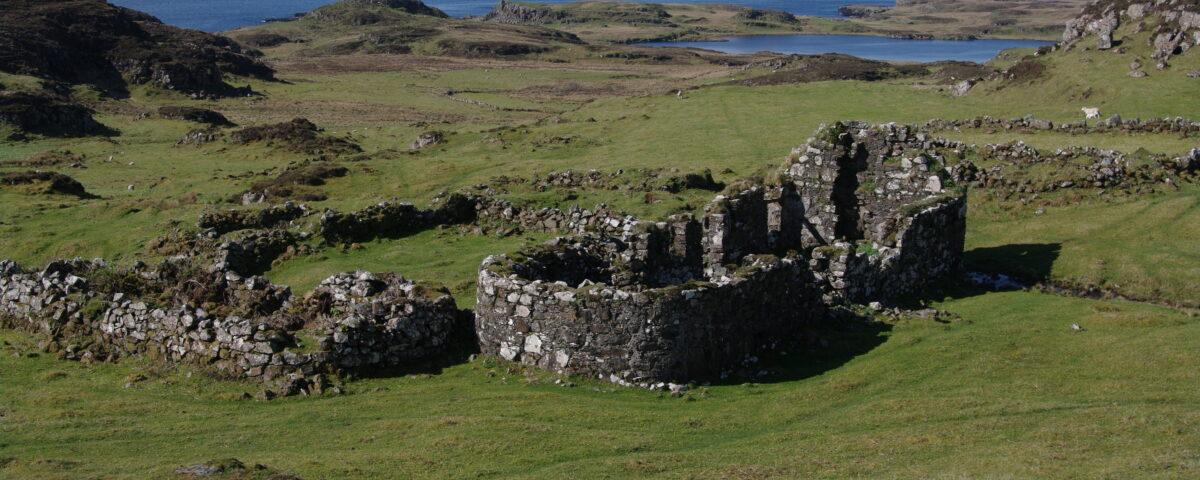
Tartan Day
14 June 2019
Available online now Issue 130 of The Clan MacLeod Magazine
11 May 2020Repopulating an Historic Skye Community – A vision for the future

Ruins of the house of the last Clan MacAskill tacksman, Rubh' an Dunain, Isle of Skye
by Gordon Mack, Editor Skye’s Hidden Heritage website & Committee member, MacAskills of Rubh’ an Dùnain Society
Occasionally, just once or twice in a lifetime perhaps, you are privileged to set foot in a special place. Somewhere that carries a tangible sense of past aeons; somewhere history has stamped its footprints into the stones and the soil; a place where it is impossible not to feel touched by the extraordinary reach of time.
For me, Rubh’ an Dùnain is that place. A remote derelict peninsula on the west coast of the Isle of Skye, uninhabited and lost to civilisation for around 160 years, save for the sheep, the deer and the otter, guarded by eagle and skua, it is a landscape that touches the soul of Celtic and West Highland heritage.
Nestled in the foothills of The Cuillins, this isolated promontory is one of the most exciting and mysterious sites of continuous human occupation in the UK. Layer upon layer of habitation over more than 5000 years is starting to be slowly peeled away. From Mesolithic remains and Iron Age fort, to Viking shipwrights, medieval canal-builders, large-scale clan cattle farming and finally the sheep-driven clearance of a generation of Gaels, Rubh’ an Dùnain represents a unique historical perspective – a time capsule waiting to be opened, as one archaeologist puts it.
In 2015 our small family – descendants of Iain ‘Dubh’ MacAskill, 17th century head of the MacAskill clan and a principle leaseholder (tacksman) of Macleod lands in the west of Skye – launched a new website, Skye’s Hidden Heritage, in an effort not only to maintain a sense of identity and kinship, but also to foster on-going research into our Rubh’ an Dùnain ancestral homeland – and, more importantly, re-sow the seeds of a new community in this beautiful and abandoned place.
The website contains an armchair virtual 13km walk examining key features of the area, and delivers historical analyses, up-to-date reports on current research and information on flora and fauna – in English and Gaelic. It has drawn praise from around the world and thousands have already visited online.
However, to continue to grow and thrive, any strong and vibrant community demands on-going friendship and support. Today, the MacAskills of Rubh’ an Dùnain Society has a vision for this intriguing land – formally designated in 2017 as one of Scotland’s newest Historic Monuments. We believe Rubh’ an Dùnain, favoured for its important military location by the MacAskills – the Macleod chiefs’ hereditary coast-watchers and bodyguards – has the potential to play a modern strategic role as a novel 21st century community.
We see our website as a catalyst for an online repopulation of the peninsula with virtual residents who could be scientists, archaeologists, historians, students, artists, musicians, school children, members of the Skye clans diaspora, Viking sailors – indeed anyone with an interest in the life, history and understanding of these islands.
We’ve given it a working title, Friends of Rubh’ an Dùnain, and we think its unique combination of history and geography, culture and heritage, offers to:
- Demonstrate the relevance of timeless history within a contemporary landscape – meeting key objectives of Historic Environment Scotland;
- Become a reference point for the study of indigenous Gaelic tradition, from boat-building to language and culture;
- Satisfy charitable funding criteria;
- Deliver its virtual residents enormous resource on many different levels;
- Develop and extend social media interaction;
- Help constrain footfall on a valuable but delicate monument, and yet still foster visitor interest in the Western Highlands of Scotland.
This is a project which is beyond the means of our small, self-supporting Society which wishes to continue primarily as a family group. We do, however, recognise that creating a new community will require hard work, a dedicated cheerleader, volunteers – and an injection of cash. But we can and do undertake to devote time and effort to help establish Friends of Rubh’ an Dùnain by:
- identifying and engaging with key stakeholders;
- helping to steer the creation of a core management team and operational structure;
- assisting with relevant set-up costs if necessary (though our own funds are limited);
- actively supervising the transition of website administration;
- helping to generate publicity as required;
- delivering enthusiasm.
The search for a cheerleader and honorary patrons is now underway. We look forward to everyone’s views – and, of course, enthusiastic volunteers.
For more information on Rubh’ an Dunain, please see Issue 120 (April 2015) of the Clan MacLeod Magazine for an article by Dr Colin J M Martin (Emeritus Reader, Maritime Studies, University of St Andrews, Scotland) and Dr Ian MacLeod (Clan MacLeod Society of Western Australia).

